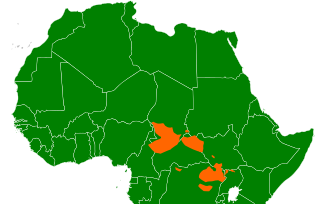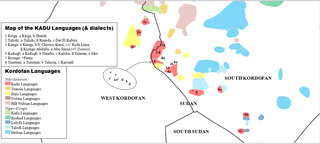Related Research Articles

The Chadic languages form a branch of the Afroasiatic language family. They are spoken in parts of the Sahel. They include 150 languages spoken across northern Nigeria, southern Niger, southern Chad, the Central African Republic, and northern Cameroon. By far the most widely spoken Chadic language is Hausa, a lingua franca of much of inland Eastern West Africa, particularly Niger and the northern half of Nigeria.

The Kordofanian languages are a geographic grouping of five language groups spoken in the Nuba Mountains of the South Kordofan region of Sudan: Talodi–Heiban languages, Lafofa languages, Rashad languages, Katla languages and Kadu languages. The first four groups are sometimes regarded as branches of the hypothetical Niger–Congo family, whereas Kadu is now widely seen as a branch of the proposed Nilo-Saharan family.

Niger–Congo is a hypothetical language family spoken over the majority of sub-Saharan Africa. It unites the Mande languages, the Atlantic-Congo languages, and possibly several smaller groups of languages that are difficult to classify. If valid, Niger-Congo would be the world's largest in terms of member languages, the third-largest in terms of speakers, and Africa's largest in terms of geographical area. It is generally considered to be the world's largest language family in terms of the number of distinct languages, just ahead of Austronesian, although this is complicated by the ambiguity about what constitutes a distinct language; the number of named Niger–Congo languages listed by Ethnologue is 1,540.

The Nilo-Saharan languages are a proposed family of African languages spoken by somewhere around 70 million speakers, mainly in the upper parts of the Chari and Nile rivers, including historic Nubia, north of where the two tributaries of the Nile meet. The languages extend through 17 nations in the northern half of Africa: from Algeria to Benin in the west; from Libya to the Democratic Republic of the Congo in the centre; and from Egypt to Tanzania in the east.

The Songhay, Songhai or Ayneha languages are a group of closely related languages/dialects centred on the middle stretches of the Niger River in the West African countries of Mali, Niger, Benin, Burkina Faso and Nigeria. In particular, they are spoken in the cities of Timbuktu, Djenné, Niamey and Gao. They have been widely used as a lingua franca in that region ever since the era of the Songhai Empire. In Mali, the government has officially adopted the dialect of Gao as the dialect to be used as a medium of primary education.
Shabo is an endangered language and likely language isolate spoken by about 400 former hunter-gatherers in southwestern Ethiopia, in the eastern part of the South West Ethiopia Peoples' Region.

The Koman languages are a small close-knit family of languages located along the Ethiopia–Sudan border with about 50,000 speakers. They are conventionally classified as part of the Nilo-Saharan family. However, due to the paucity of evidence, many scholars treat it as an independent language family. Among scholars who do accept its inclusion within Nilo-Saharan, opinions vary as to their position within it.

The Nilotic languages are a group of related languages spoken across a wide area between South Sudan and Tanzania by the Nilotic peoples.

In most classifications, the Eastern Sudanic languages are a group of nine families of languages that may constitute a branch of the Nilo-Saharan language family. Eastern Sudanic languages are spoken from southern Egypt to northern Tanzania.

Central Sudanic is a family of about sixty languages that have been included in the proposed Nilo-Saharan language family. Central Sudanic languages are spoken in the Central African Republic, Chad, South Sudan, Uganda, Congo (DRC), Nigeria and Cameroon. They include the pygmy languages Efé and Asoa.

The Kadu languages, also known as Kadugli–Krongo or Tumtum, are a small language family of the Kordofanian geographic grouping, once included in Niger–Congo. However, since Thilo Schadeberg (1981), Kadu is widely seen as Nilo-Saharan. Evidence for a Niger-Congo affiliation is rejected, and a Nilo-Saharan relationship is controversial. A conservative classification would treat the Kadu languages as an independent family.
The Gumuz are an ethnic group speaking a Nilo-Saharan language inhabiting the Benishangul-Gumuz Region in western Ethiopia, as well as the Fazogli region in Sudan. They speak the Gumuz language, which belongs to the Nilo-Saharan family. The Gumuz number around 250,000 individuals.

The Majang language is spoken by the Majangir people of Ethiopia. Although it is a member of the Surmic language cluster, it is the most isolated one in the group. A language survey has shown that dialect variation from north to south is minor and does not seriously impede communication. The 2007 Ethiopian Census lists 6,433 speakers for Majang (Messengo), but also reports that the ethnic group consists of 32,822 individuals. According to the census, almost no speakers can be found in Mezhenger Zone of Gambela Region; a total of eleven speakers are listed for the zone, but almost 10,000 ethnic Mejenger or Messengo people.
The Bʼaga languages, also known as Gumuz, form small language family spoken along the border of Ethiopia and Sudan. They have been tentatively classified as closest to the Koman languages within the Nilo-Saharan language family.

The Talodi–Heiban languages are a proposed branch of the hypothetical Niger–Congo family, spoken in the Nuba Mountains of Sudan. The Talodi and Heiban languages are thought to be distantly related by Dimmendaal, though Glottolog 4.4 does not accept the unity of Talodi–Heiban pending further evidence.

The Shabo are an ethnic group of southwestern Ethiopia. They call themselves "Sabu" and are sometimes called "Mikeyir" by their neighbors. Their language is of uncertain classification and shows some similarities with the Nilo-Saharan, particularly Koman, languages. The Shabo live in several dispersed settlements in the regional states of the Gambela Region and the Southern Nations, Nationalities, and People's Region, surrounded by Majangir and Shekkacho peoples, with whom they intermarry. The former have heavily influenced Shabo culture. The Shabo have adopted several customs and elements of material culture from the Majangir.
Gule, also known as Anej, Fecakomodiyo, and Hamej, is an extinct language of Sudan. It is generally classified as one of the Koman languages. It is poorly attested, and Hammarström judges the evidence to be insufficient for classification as Koman. Others however accept it as Koman, though too poorly attested to be much help in reconstructing that family.
Gumuz is a dialect cluster spoken along the border of Ethiopia and Sudan. It has been tentatively classified within the Nilo-Saharan family. Most Ethiopian speakers live in Kamashi Zone and Metekel Zone of the Benishangul-Gumuz Region, although a group of 1,000 reportedly live outside the town of Welkite. The Sudanese speakers live in the area east of Er Roseires, around Famaka and Fazoglo on the Blue Nile, extending north along the border. Dimmendaal et al. (2019) suspect that the poorly attested varieties spoken along the river constitute a distinct language, Kadallu.
Kadallu is a poorly attested Gumuz language of southeastern Sudan. It is known only from two short word lists. It is spoken on the Blue Nile in the southeastern corner of Sudan, in the area surrounding Ad-Damazin and Er Roseires, and just south-southeast of Famaka near the Ethiopian border.
Gerrit Jan Dimmendaal is a Dutch linguist and Africanist. His research interests focused mainly on the Nilo-Saharan languages.
References
- ↑ Müller, André, Viveka Velupillai, Søren Wichmann, Cecil H. Brown, Eric W. Holman, Sebastian Sauppe, Pamela Brown, Harald Hammarström, Oleg Belyaev, Johann-Mattis List, Dik Bakker, Dmitri Egorov, Matthias Urban, Robert Mailhammer, Matthew S. Dryer, Evgenia Korovina, David Beck, Helen Geyer, Pattie Epps, Anthony Grant, and Pilar Valenzuela. 2013. ASJP World Language Trees of Lexical Similarity: Version 4 (October 2013) .
- Colleen Ahland, "The Classification of Gumuz and Koman Languages", presented at the Language Isolates in Africa workshop, Lyons, December 4, 2010
- Colleen Ahland, 2012. "A Grammar of Northern and Southern Gumuz", doctoral dissertation, University of Oregon.
- Lionel Bender, 1983. "Proto-Koman phonology and lexicon", "Afrika und Übersee" 66: 259–297.
- Lionel Bender, 1991. "Subclassification of Nilo-Saharan". In M. Lionel Bender, ed., Proceedings of the Fourth Nilo-Saharan Linguistics Colloquium, Bayreuth, Aug.30-Sep.2, 1989. NISA 7, 1–35. Hamburg: Helmut Buske Verlag.
- Lionel Bender, 1996. "The Nilo-Saharan languages: a comparative essay", Munich: Lincom Europa.
- Lionel Bender, 2000. "Nilo-Saharan". In Bernd Heine and Derek Nurse, eds., African Languages: An Introduction. Cambridge University Press.
- Roger Blench, 2010. Commentary on Ahland (2010) at the Language Isolates in Africa workshop, Lyons, December 4, 2010
- Gerrit Dimmendaal, 2008. "Language Ecology and Linguistic Diversity on the African Continent", Language and Linguistics Compass 2/5:842.
- Gerrit J. Dimmendaal, 2011. "Historical linguistics and the comparative study of African languages". Philadelphia: John Benjamins.
- Joseph Greenberg, 1963. The Languages of Africa (International Journal of American Linguistics 29.1). Bloomington, IN: Indiana University Press.
- Tyler Schnoebelen, 2009. "(Un)classifying Shabo: phylogenetic methods and results". Peter K. Austin, Oliver Bond, Monik Charette, David Nathan & Peter Sells, eds., Proceedings of Conference on Language Documentation and Linguistic Theory 2. London: SOAS. (long version, unpublished )